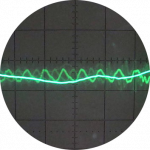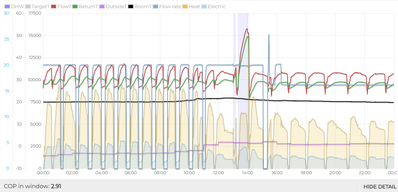I need to temper my previous statement. This Daikin is running a very high room temperature of 23C which means the flow temperature is too high for a more reasonable room temperature. Many others with good COP run room temperatures of 19C. The Daikin COP of 4.3 could be improved by up to 10% so its performance is not too bad. Furthermore, water pump consumption is frequently not reported. The Daikin running at 7 l/min also saves a bit on pump power compared to high fixed flow ones.
Private individual. No affiliation with commercial "Heat Geeks" of same coincidental name.
@heatgeek I feel this may all be heading towards a conclusion that there are a set of trade offs in compressor modulation range and cycling. Without a good handle on the penalties of cycling, or indeed the penalties of operating a compressor at either end of it's modulation curve, it's difficult to be sure where those land.
This is confounded by the likelihood that heat pump designers probably try to optimise for the things they are required by regulation to declare, which may or may not be what we experience, and also almost certainly design for the situation where the heat pump is 'right sized' whereas in reality that is probably rare.
My gut feel (which I hope is wrong) is that there is no silver bullet/right answer, because if there were surely most heat pump manufacturers would have drifted towards it. The introduction by Mitsubishi of a two- compressor machine seems hugely significant to me. It's not going to be cheap to add a compressor and develop the software to control it, so it feels like an admission that they don't have a way to extend modulation ratio purely by different control algorithms, and need to make a significant hardware change instead. It will be interesting to see if others follow suit.
I would personally like to see more numerical data on the penalty of cycling. Other than the examples on the John Cantor video I don't know of any!
4kW peak of solar PV since 2011; EV and a 1930s house which has been partially renovated to improve its efficiency. 7kW Vaillant heat pump.
@old_scientist Apologies for the late reply. My 500,000 mile check-up was due with the quack. There are three DT’s to consider. Room-to-outside, emitter-to-room and water flow DT. The emitter-to-room DT must match the room-to-outside DT to achieve balance. This is what WC does. Therefore, if outside temperature remains constant, increasing the flow temperature will increase heat flow into the room and raise its temperature. DT x SH x Flow of water gives the heat power delivered. Assuming that the average temperature of the radiator is always maintained by any change, changing the combination of flow and DT values will not alter the heat flow into the room as the rad-room DT is being maintained. Running higher flow temperature is less efficient, as you say.
A 12kW HP needs a flow of 36 l/min to achieve full output at DT 5C. You are already running a reduced flow at 24 l/min which at DT 3C gives 5kW with reduced/eliminated peak cycling at your flow temperature. You are doing what I have been advocating all along for over-sized HP’s instead of running fixed maximum water flow with extremely low DT like some others. Reducing flow further will widen the DT for the same power output but there is no real benefit in doing that unless you are getting down to 1C DT. The power output will be the same. You certainly seem to be on the right track in my view.
Private individual. No affiliation with commercial "Heat Geeks" of same coincidental name.
@jamespa Talking about Mitsubishi, the @RobS post early on in this thread re 8kW R290 Mitsubishi is interesting as this unit is achieving constant 2kW low output @~2C DT with very high COP of 5.86 at OAT 10-15C. There are some questions I would like to get around to with @RobS about this unit as it ran at constant 20 l/min in the January cold spell and then dropped to constant 15 l/min afterwards when this graph was produced. An 8kW unit needs 24l/min @5C DT for full output so I assume that it is over-sized.
Private individual. No affiliation with commercial "Heat Geeks" of same coincidental name.
Posted by: @jamespaI would personally like to see more numerical data on the penalty of cycling. Other than the examples on the John Cantor video I don't know of any!
Theoretically there should be no penalty if there is no power surge on initiation. However, both Samsung and Daikin appear to have a designed-in period of high output before dropping to normal output. Presumably this is to bring room temperature up quickly but is anathema for rapid cycling. This start-up period was confirmed by the owner of the Ipswich Daikin whose user name I can’t recall.
Private individual. No affiliation with commercial "Heat Geeks" of same coincidental name.
@heatgeek Octopus recommended a Daikin 8kW for my property, but I wanted the Cosy6, 5.6kW, as it used R290. I had to agree to improve the insulation to get them to MCS certify the install to get the BUS grant. Im half way through renovating my house, again Octopus don't install in renovations so again I had to commit to how the building will be insulated when finished.
I have UFH downstairs and it was the best decision I made, it’s invisible when done properly and I had a Gyproc screed instead of Concrete as its 2x thermally efficient.
Flow rate of the system is 12-15l/m running at 40C outlet temp, lowest setting I can find, perfect for 37C inlet temp to UFH
@agentgeorge I also have UFH with 4kW HP unit. I agree with your sentiments. UFH is the only way to go. Radiators just complicate things and it is well worth going the extra mile. You were very wise to spend money on insulation first. Exactly what I did on renovation to go full UFH, smaller HP and lower bills. Digging up the floors to insulate them was a mission though.
Not familiar with the Cosy6. Does it have DT flow control like the Daikin/Samsung or fixed flow? You mention constant temperature setting. Are you not using weather compensation? Why are you dropping 3C on your input to UFH? My HP with internal PWM pump is connected directly via volumizer to the manifold without any mixer, only flow meter and 2 thermometers on input/output to observe overall 5C DT and cheap Caleffi plug-on mini-thermometers on every return pipe to manage loop DT temperatures. Pure simplicity. I went with 7cm concrete screed rather for better thermal mass. Works for me. Glad to hear that there are kindred souls out there.
Private individual. No affiliation with commercial "Heat Geeks" of same coincidental name.
Posted by: @jamespa@heatgeek I feel this may all be heading towards a conclusion that there are a set of trade offs in compressor modulation range and cycling. Without a good handle on the penalties of cycling, or indeed the penalties of operating a compressor at either end of it's modulation curve, it's difficult to be sure where those land.
This is confounded by the likelihood that heat pump designers probably try to optimise for the things they are required by regulation to declare, which may or may not be what we experience, and also almost certainly design for the situation where the heat pump is 'right sized' whereas in reality that is probably rare.
My gut feel (which I hope is wrong) is that there is no silver bullet/right answer, because if there were surely most heat pump manufacturers would have drifted towards it. The introduction by Mitsubishi of a two- compressor machine seems hugely significant to me. It's not going to be cheap to add a compressor and develop the software to control it, so it feels like an admission that they don't have a way to extend modulation ratio purely by different control algorithms, and need to make a significant hardware change instead. It will be interesting to see if others follow suit.
I would personally like to see more numerical data on the penalty of cycling. Other than the examples on the John Cantor video I don't know of any!
Agree with the above. Without knowing what the modulation curve of any given heat pump/compressor looks like, about all we can do is assume the manufacturer has limited the modulation range so as not to allow efficiency to drop off a cliff. There's little point allowing a compressor to modulate down to 10% or 20% if the efficiency within that range is horrendous. It's probably going to be better to limit it to 25-30% and accept some cycling (substitute numbers as appropriate to your compressor efficiency).
If at mild OATs, maximum efficiency is in the 40% region, cycling may not be that bad, as cycling off and allowing the water to cool to say 25C and then reheating back to a flow temp of 30-35C may result in the heat pump working in exactly that region where it is most efficient with the extra energy used to reheat the water offset by the energy saved during the cycled off period, which may be more efficient than modulating down to 10-20% where efficiency is really poor and running continuously.
Samsung 12kW gen6 ASHP with 50L volumiser and all new large radiators. 7.2kWp solar (south facing), Tesla PW3 (13.5kW)
Solar generation completely offsets ASHP usage annually. We no longer burn ~1600L of kerosene annually.
Posted by: @heatgeek@jamespa Talking about Mitsubishi, the @RobS post early on in this thread re 8kW R290 Mitsubishi is interesting as this unit is achieving constant 2kW low output @~2C DT with very high COP of 5.86 at OAT 10-15C. There are some questions I would like to get around to with @RobS about this unit as it ran at constant 20 l/min in the January cold spell and then dropped to constant 15 l/min afterwards when this graph was produced. An 8kW unit needs 24l/min @5C DT for full output so I assume that it is over-sized.
Happy to answer questions about our 8kW Mitsubishi. Yes, it's able to run at ~2.0kW output for extend periods with a dT of ~2C and a COP of 5.5-6.5.
The 20 l/min in Jan was just me experimenting with different settings, basically 20 l/min with a dT of 6C or 15.5 l/min with a dT of 8C.
Yes, it's inevitably oversized (MCS) but the two compressors have mitigated most of the consequences.
Posted by: @old_scientistWithout knowing what the modulation curve of any given heat pump/compressor looks like, about all we can do is assume the manufacturer has limited the modulation range so as not to allow efficiency to drop off a cliff. There's little point allowing a compressor to modulate down to 10% or 20% if the efficiency within that range is horrendous. It's probably going to be better to limit it to 25-30% and accept some cycling (substitute numbers as appropriate to your compressor efficiency).
If at mild OATs, maximum efficiency is in the 40% region, cycling may not be that bad, as cycling off and allowing the water to cool to say 25C and then reheating back to a flow temp of 30-35C may result in the heat pump working in exactly that region where it is most efficient with the extra energy used to reheat the water offset by the energy saved during the cycled off period, which may be more efficient than modulating down to 10-20% where efficiency is really poor and running continuously.
That's a good analysis. Presumably heat pump manufacturers design on the assumption that the heat pump is right sized. The typical oversized heat pump will probably therefore be working mostly at the bottom end of the modulation curve much of the time, potentially quite significantly compromising COP (notwithstanding the claims of some that oversizing is OK)
4kW peak of solar PV since 2011; EV and a 1930s house which has been partially renovated to improve its efficiency. 7kW Vaillant heat pump.
Posted by: @jamespaPosted by: @old_scientistWithout knowing what the modulation curve of any given heat pump/compressor looks like, about all we can do is assume the manufacturer has limited the modulation range so as not to allow efficiency to drop off a cliff. There's little point allowing a compressor to modulate down to 10% or 20% if the efficiency within that range is horrendous. It's probably going to be better to limit it to 25-30% and accept some cycling (substitute numbers as appropriate to your compressor efficiency).
If at mild OATs, maximum efficiency is in the 40% region, cycling may not be that bad, as cycling off and allowing the water to cool to say 25C and then reheating back to a flow temp of 30-35C may result in the heat pump working in exactly that region where it is most efficient with the extra energy used to reheat the water offset by the energy saved during the cycled off period, which may be more efficient than modulating down to 10-20% where efficiency is really poor and running continuously.
That's a good analysis. Presumably heat pump manufacturers design on the assumption that the heat pump is right sized. The typical oversized heat pump will probably therefore be working mostly at the bottom end of the modulation curve much of the time, potentially quite significantly compromising COP (notwithstanding the claims of some that oversizing is OK)
That's largely where I am, with a 12kW Samsung unit and on our coldest day last January with produced 96kWh of heat, so an implied heat loss of ~4kW.
I don't have any monitoring other than what's available from the Samsung controller (heat generated) and a MID electric meter recording electricity usage of the ASHP. We do spend a fair amount of time running at the lower end of the curve, and the observed COPs are very much inline with the published literature from Samsung, so we certainly seem to be in the right ballpark and I have no complaints. When it's cold we can achieve extended runs at low flow temps of 30-32C. When it's warmer, 32-33C is the lowest flow temp that will allow the radiators to emit the heat being produced, so we run for an hour or two as required, then switch off for a bit. We allow the room stats to control the on/off call for heat rather than let the heat pump cycle, but that's just how we prefer to manage it.
Our 12kW unit is actually a software-limited 16kW unit, so using the 25% rule of thumb, would expect it to modulate down to around 3-4kW. Minimum input seems to be around 800W, so with a COP of 4 we'd expect ~3.2kW output, depending on OAT and that aligns with the amount of heat being dissipated by our radiators at a minimum flow temp of 32-33C in milder weather.
TBH, because of the way we time shift usage on the Cosy tariff and use overnight switch offs (and commensurate reheats the next day), we probably do not spend that much time running on absolute minimum (25%), and are probably running a little higher up the curve where efficiency is better, although by no means do we ever stretch our unit (other than on the short daily DHW runs).
We are hoping to add a battery which will completely change the way we use the system next winter, allowing more constant low running as the TOU tariff is flattened by the battery storage. We will still set back overnight as the unit still puts out too much heat for comfortable sleeping, even on minimum, so will be working a little harder in the mornings, but nowhere near to the extent we do now, and we will no longer need to switch off during the 4-7pm peak. It will be interesting to see how this affects our monthly SCOPs compared to last winter
Samsung 12kW gen6 ASHP with 50L volumiser and all new large radiators. 7.2kWp solar (south facing), Tesla PW3 (13.5kW)
Solar generation completely offsets ASHP usage annually. We no longer burn ~1600L of kerosene annually.
@robs Thank you for this. I attach a graph from the change you made. It is very interesting that you have reduced the flow to broaden the DT as this is what I have been advocating and some of the cognoscenti poo-poo this. What do you conclude from this? What do you think would happen if you reduced flow further? What is the ideal setting? Do you believe that this is the way to tame down over-sized HP’s?
The other issue is the residual cycling at low OAT temperatures. It broadened out when flow temperature reduced. This persists later in January. This suggests that the flow temperature may still be too high as the AVERAGE flow temperature is a few degrees lower than peak. Each start-up seems to cause a higher power surge before dropping which could affect COP. Have you tried lowering the flow temperature further to eliminate this cycling?
This certainly looks like an interesting machine. Does it still have the external long NTC leads for measuring the flow and return temperatures? What happens at mild temperatures - presumably it turns one of the compressors off? Do you know at which point that happens?
Well done. Looks like you made a good choice.
Private individual. No affiliation with commercial "Heat Geeks" of same coincidental name.
- 26 Forums
- 2,342 Topics
- 53 K Posts
- 293 Online
- 6,000 Members
Join Us!
Worth Watching
Latest Posts
-

RE: Are We Sleepwalking Into Another Race to the Bottom?
…otherwise known as “hive got news for you”. And don’...
By Majordennisbloodnok , 39 minutes ago
-
RE: Configuring third party dongle for Ecodan local control
Logically, I'll fall into that category so the natural ...
By Sheriff Fatman , 1 hour ago
-

RE: Controlling Daikin Altherma via P1P2 and Home Assistant
I haven’t got a Daikin but I have been having some fun ...
By Majordennisbloodnok , 2 hours ago
-

RE: Setback savings - fact or fiction?
@robs — thanks again for your detailed comments. Some r...
By cathodeRay , 4 hours ago
-
RE: Free Ecoheat Heat Pump Install
I don't mind thread drift, it's how conversation natura...
By Deltona , 5 hours ago
-

RE: A Smarter Smart Controller from Homely?
@papahuhu I hope you get a swift resolution. Regards, T...
By Toodles , 8 hours ago
-

RE: Poll for Time of Use, tariffs, technology
That’s fine by me too Major, I feel it is a sad reflect...
By Toodles , 9 hours ago
-

Bingo. Sometimes a judiciously placed size 10 bovver bo...
By Majordennisbloodnok , 9 hours ago
-
RE: Mitsubishi Ecodan 11.2kW heat pump with low COP
@ciocoiu-alexandru I can't provide the same level of di...
By Sheriff Fatman , 10 hours ago
-
RE: Octopus Cosy Heat Pump Owners & Discussion Thread
Recently had my follow up with octopus for the vibratio...
By swwils , 11 hours ago
-

The three technical issues I'm considering are: BMS...
By Transparent , 12 hours ago
-
RE: LiFePO4 lithium battery fires and explosions
@transparent Your post may fit better in th...
By Batpred , 12 hours ago
-

RE: British Gas vs Octopus Energy vs Heat Geek vs EDF vs Aira vs OVO vs EON.Next vs Boxt
@jamespawhite, if you could be bothered, you could also...
By Mars , 14 hours ago
-
RE: Commencing on an ASHP Installation Process
I've got a bit of time to draft something today, so the...
By Sheriff Fatman , 1 day ago
-
RE: Help with heat pump sizing
@amin I dont think materially relative to t...
By JamesPa , 1 day ago
-

@majordennisbloodnok I have decided to take the plunge....
By TechnoGeek , 1 day ago
-
RE: Different dT on each radiator?
I cant sorry. Its based on some calculations I did fro...
By JamesPa , 2 days ago
-
RE: Help me keep the faith with my air source heat pump installation
@simonf thats interesting as I’ve noticed my flow and r...
By AdamK , 2 days ago






